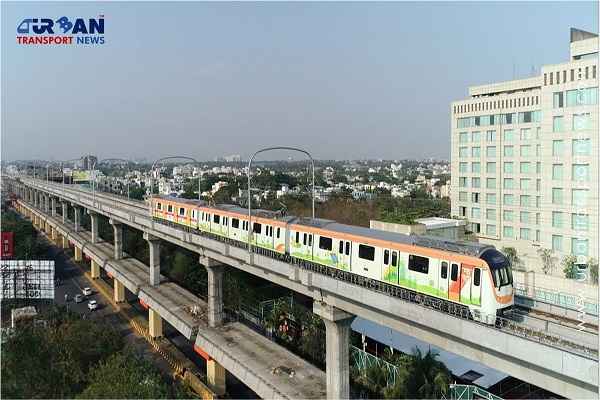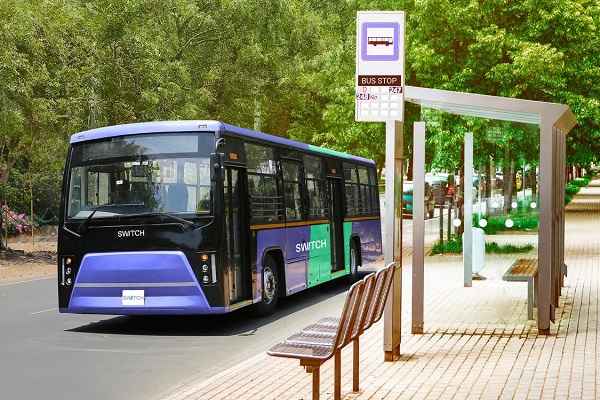 Delhi unveils ambitious Urban Mobility Vision: Luxury Metro Coaches, New Tunnels and Pod Taxi
Delhi unveils ambitious Urban Mobility Vision: Luxury Metro Coaches, New Tunnels and Pod Taxi Qatar approves Saudi Rail Link Agreement, Accelerating Gulf Railway Vision 2030
Qatar approves Saudi Rail Link Agreement, Accelerating Gulf Railway Vision 2030 UP Govt plans to introduce Water Metro services in Ayodhya, Varanasi & Prayagraj
UP Govt plans to introduce Water Metro services in Ayodhya, Varanasi & Prayagraj India’s First Urban Ropeway begins Trial Run in Varanasi, Set to carry 1 Lakh passengers daily
India’s First Urban Ropeway begins Trial Run in Varanasi, Set to carry 1 Lakh passengers daily India and Bhutan to Build First-Ever Rail Link: ₹4,033 Cr Project to Boost Regional Connectivity
India and Bhutan to Build First-Ever Rail Link: ₹4,033 Cr Project to Boost Regional Connectivity Patna to launch Eco-Friendly Water Metro; Trial Run soon between Digha and Kangan Ghats
Patna to launch Eco-Friendly Water Metro; Trial Run soon between Digha and Kangan Ghats Air India Group set to launch Flights Operations from Navi Mumbai International Airport
Air India Group set to launch Flights Operations from Navi Mumbai International Airport Chennai to launch 25-Year Mobility Plan with Unified QR Ticketing and One-App Transit System
Chennai to launch 25-Year Mobility Plan with Unified QR Ticketing and One-App Transit System Kochi Metro bags ₹4.4 crore contract to prepare DPR for Mumbai Water Metro Proejct
Kochi Metro bags ₹4.4 crore contract to prepare DPR for Mumbai Water Metro Proejct Navi Mumbai International Airport set for September launch; IndiGo and Akasa Air to lead Operations
Navi Mumbai International Airport set for September launch; IndiGo and Akasa Air to lead Operations
Role of Management in creating Sustainable Development in India

This research paper is a topline review of the Role of Management in creating sustainable development in India. In this review, articles related to sustainable development in global and India had been reviewed from the source of multiple sources. This study found that there are only a few pieces of literature regarding the management of sustainable development in India and many of the SDGs were unexplored by the researchers. This research is concluded by identifying the SDGs of gender equality, reduction in inequality, peace, and justice, and responsible consumption and production as the most promising niches for future research in the area role of management approach and practices to ensure sustainable development in India.
Introduction
Development is a process of enlarging the range of people’s choices, increasing their opportunities for education, health care, income, and empowerment, and covering the full range of human choices from a sound physical environment to economic, social, and political freedom.
Unplanned development will inevitably lead to the depletion of resources and the destruction of the environment, the capital of humanity. Hence, the need to modify the traditional concept of development of the Public Transport system by associating it with sustainability, and the achievement of sustainable development has become the ultimate goal of the nations.
Sustainability is the foundation for today’s leading global framework for international cooperation and it is essential to address the requirement of stakeholders, the environment, global economics, business, individuals, and governments to achieve the overall goal for the benefit of the human. Sustainable development is the key to the overall prosperity of the world.
As per the former secretary-general of the UN, Mr. Ban Ki Moon -
Sustainable development is the pathway to the future we want for all. It offers a framework to generate economic growth, achieve social justice, exercise environmental stewardship, and strengthen governance.
The concept of Sustainable development is based on the following principles
- Integration of environmental and economic decision
- Stewardship or humans as the caretaker of the environment
- Shared responsibility, accountability, and decision making
- Prevention and mitigation
- Conservation Waste minimization
- Enhancement of productivity, capability, quality of nature, and human life
- Rehabilitation and reclamation
- Scientific and technological innovations
The principle of sustainable development (SD) also embodies a road map toward securing the present and future needs of the community and all mankind without compromising the ability of future generations to meet their needs. It does provide valuable ideas for the ideal utilization of the sources and sustaining them. The philosophy of sustainable development aims at providing for the needs of the current generation and developing its living conditions in a way that does not affect the needs of future generations.
The concept of sustainable development, although had appeared in the 1970s, was widely disseminated in the early 1980s by the ‘World Conservation Strategy’ (IUCN, UNE’P and WWF, 1980), which called for the maintenance of essential ecological processes; the preservation of biodiversity; and sustainable use of species and ecosystems.
The Sustainable Development Goals (SDGs), also known as the Global Goals, were adopted by the United Nations in 2015 as a universal call to action to end poverty, protect the planet, and ensure that by 2030 all people enjoy peace and prosperity.
Sustainable Development Goal (SDG)
- Goal 1: No Poverty: Eradicating poverty and ensuring equal access to resources and opportunities for all citizens.
- Goal 2: Zero Hunger: Working to end hunger, achieve food security, improve nutrition, and promote sustainable agriculture.
- Goal 3: Good Health and Well-being: Ensuring healthy lives and promoting well-being for all age groups.
- Goal 4: Quality Education: Ensuring inclusive and quality education for all, aiming to provide equitable access to education and lifelong learning opportunities.
- Goal 5: Gender Equality: Promoting gender equality and empowering women and girls to participate fully in all aspects of society.
- Goal 6: Clean Water and Sanitation: Ensuring access to clean water and proper sanitation for all citizens.
- Goal 7: Affordable and Clean Energy: Increasing the share of renewable energy in the energy mix and promoting energy efficiency.
- Goal 8: Decent Work and Economic Growth: Promoting sustainable economic growth, full and productive employment, and decent work for all.
- Goal 9: Industry, Innovation, and Infrastructure: Building resilient infrastructure, promoting inclusive and sustainable industrialization, and fostering innovation.
- Goal 11: Sustainable Cities and Communities: Making cities and human settlements inclusive, safe, resilient, and sustainable.
- Goal 12: Responsible Consumption and Production: Promoting sustainable consumption and production patterns and managing resources efficiently.
- Goal 13: Climate Action: Taking urgent action to combat climate change and its impacts.
- Goal 15: Life on Land: Protecting, restoring, and promoting sustainable use of terrestrial ecosystems, and halting biodiversity loss.
- Goal 16: Peace, Justice, and Strong Institutions: Promoting peaceful and inclusive societies, providing access to justice for all, and building effective, accountable, and inclusive institutions at all levels.
Indian Growth and Sustainable Development
India has reinforced the country’s belief in its economic resilience as it has withstood the challenge of mitigating external imbalances caused by the Russian-Ukraine conflict without losing growth momentum in the process. India’s stock markets had a positive return in CY22, unfazed by withdrawals by foreign portfolio investors. India’s inflation rate did not creep too far above its tolerance range compared to several advanced nations and regions.
India's Real GDP growth projections by various agencies (percent)
| Agency |
2022 (Revised Estimates) |
2022 (Previous Estimates) |
| International Monetary Fund (IMF) | 8.2 | 9.0 |
| The World Bank | 7.5 | 8.0 |
| Asian Development Bank (ADB) | 7.5 | NA |
| Reserve Bank of India (RBI) | 7.2 | 7.5 |
| Moody's Investor Service | 8.8 | 9.1 |
| S&P Global Ratings | 7.3 | 7.8 |
| Fitch Ratings | 8.5 | 10.3 |
Looking ahead, the IMF forecasts this to become the new status quo, with India expected to leap further ahead of the UK up to 2027 - making India the fourth largest economy by that time, too, and leaving the UK behind in sixth.
India, the fastest growing economic country like many other countries, is committed to achieving the Sustainable Development Goals (SDGs) set by the United Nations. These global goals aim to address various social, economic, and environmental challenges by 2030. India's commitment to the SDGs reflects its dedication to sustainable development and improving the well-being of its citizens.
The 17 SDGs and 169 targets are part of a transformative agenda - the 2030 Agenda for Sustainable Development adopted by 193 Member States at the UN General Assembly Summit in September 2015, and which came into effect on 1 January 2016. At the core of this global agenda for 2030 is the principle of universality: ‘Leave No One Behind’.
It is well known that development in all its dimensions must include all people, everywhere, and should be built through the participation of everyone, especially the most vulnerable and marginalized. The comprehensive agenda recognizes that it is no longer sufficient just to focus on economic growth but on fairer and more equal societies, and a safer and more prosperous planet.
India has made significant progress toward achieving some of these goals, but challenges still remain. The government, in collaboration with various stakeholders, is continuously working to implement policies and initiatives to advance the SDGs and create a more sustainable and inclusive future for the country.
A key component of India's SDG plan is the country's audacious Nationally Determined Contributions (NDC), which it presented to the Conference of the Parties (COP) of the UN Framework Convention on Climate Change. These include expanding carbon sinks, using non-fossil fuel energy sources, and significantly lowering GDP's emission intensity.
India is critical in determining the success of the SDGs, globally. At the UN Sustainable Development Summit in 2015, Prime Minister Narendra Modi noted, “Sustainable development of one-sixth of humanity will be of great consequence to the world and our beautiful planet.
It will be a world of fewer challenges and greater hope; and, more confidence of its success”. The National Institution for Transforming India (NITI Aayog), the Government of India’s premier think tank, has been entrusted with the task of coordinating the SDGs, implementation by mapping schemes related to the SDGs and their targets, and identifying lead and supporting ministries for each target. In addition, the Ministry of Statistics and Programme Implementation (MoSPI) has been leading discussions for developing national indicators for the SDGs.
State governments are key to India’s progress on the SDGs as they are best placed to ‘put people first’ and to ensure that ‘no one is left behind’. The UN Country Team in India supports NITI Aayog, Union ministries, and state governments in their efforts to address the interconnectedness of the goals, to ensure that no one is left behind, and to advocate for adequate financing to achieve the SDGs.
Major Challenges in Creating Sustainable Development in India
India faces several key challenges in achieving sustainable development. While progress has been made in various areas, these challenges remain significant and require concerted efforts from the government, businesses, civil society, and individuals. Some of the key challenges include:
- Population Growth: India's large and growing population ( approx. 140Bn) puts immense pressure on natural resources, infrastructure, and services, making it challenging to meet the needs of all citizens sustainably.
- Poverty and Inequality: Addressing poverty and reducing inequality is a fundamental aspect of sustainable development. Disparities in income, access to education, healthcare, and opportunities hinder progress.
- Environmental Degradation: India faces environmental issues such as air and water pollution, deforestation, soil degradation, and loss of biodiversity. Balancing economic growth with environmental protection is a significant challenge.
- Climate Change: India is vulnerable to the impacts of climate change, including extreme weather events, sea-level rise, and changing rainfall patterns. Mitigating and adapting to climate change remains a priority.
- Water Scarcity: Many regions in India experience water scarcity, and improper water management exacerbates the problem. Ensuring sustainable use and management of water resources is crucial.
- Energy Security: India's growing energy demand poses challenges in providing reliable and sustainable energy sources while reducing reliance on fossil fuels.
- Urbanization and Infrastructure: Rapid urbanization places strain on infrastructure, public services, and housing. Creating sustainable and well-planned cities is essential.
- Waste Management: India generates massive amounts of waste, and proper waste management and recycling practices need improvement.
- Health and Sanitation: Ensuring access to quality healthcare and sanitation services, particularly in rural areas, is critical for overall well-being and development.
- Education and Skill Development: Enhancing the quality of education and providing relevant skills training are essential to foster a skilled workforce for sustainable economic growth.
- Localization of Governance: poor governance hinders sustainable development efforts by diverting resources and undermining trust in institutions.
- Natural Resource Depletion: Unsustainable exploitation of natural resources, such as minerals and forests, can lead to depletion and environmental degradation.
- Inclusive Development: Ensuring that development reaches all segments of society, including marginalized communities, is a challenge that requires targeted policies and interventions.
- Public Awareness and Participation: Increasing awareness and involving the public in sustainable practices are crucial for achieving lasting change.
- Conflict and Security Issues: Conflicts and security concerns can disrupt development efforts and divert resources from sustainable development goals.
Addressing major challenges requires a holistic and integrated approach, involving strong policy frameworks, effective governance, public-private partnerships, and active participation from all stakeholders.
Key areas to focus on with better Management.
To create sustainable development in India, a comprehensive management approach is essential. This approach should involve various strategies and actions to address the challenges mentioned earlier and promote sustainable practices across different sectors. A necessity for conducting a thorough analysis of the elements influencing the incorporation of the idea of sustainable development by inducting a management approach and process in order to pinpoint the major motivators and obstacles to its effective adoption. Need for better management for sustainable development and inclusive growth of india.
Here are some key elements with Management process and practices for Future development:
- National Sustainable Development Strategy: Formulate and implement a national sustainable development strategy that outlines clear goals, targets, and timelines for achieving the Sustainable Development Goals (SDGs). This strategy should involve multiple stakeholders and be regularly updated to align with changing circumstances. Develop a long-term sustainability vision and strategy that aligns with India's development priorities. Emphasize the importance of sustainable practices as a core value and driver of overall success.
- Policy Integration: Ensure that sustainable development considerations are integrated into all relevant policies and sectors, including agriculture, energy, transportation, urban planning, and industry. This will foster a more coordinated and coherent approach to sustainability.
- Local Context Awareness: Understand the specific environmental, social, and economic challenges in India, considering factors such as population density, resource availability, climate variability, and cultural diversity. Tailor sustainability initiatives to address these local challenges effectively.
- Government Policies and Regulations: Stay informed about relevant sustainability policies, regulations, and initiatives set forth by the Indian government. Align organizational practices with these policies to ensure compliance and take advantage of any incentives or support available.
- Focus on Sustainable Urbanization:According to the 2011 Census of India, 68.8% of the Indian population lives in rural and only 31.2% of the population lives in urban regions. Urbanization has vast economic potential for services and infrastructure that may aid in sustainable development. India's 100 Smart Cities initiative was inspired by the expectation that more than 50% of the country's population would live in Indian cities by the year 2050..
- Engaging Stakeholders: Engage with a diverse group of stakeholders, including local communities, government bodies, NGOs, suppliers, and customers. Involve them in sustainability initiatives, seek their input, and address their concerns to build partnerships and gain support.
- Public-Private Partnerships: Encourage partnerships between the government, private sector, civil society organizations, and academia to leverage resources, expertise, and innovation for sustainable development projects and initiatives.
- Institutional Framework: Strengthen existing institutions and establish new ones to oversee and coordinate sustainable development efforts at the national, state, and local levels. This includes creating specialized bodies to address specific sustainability issues like climate change, renewable energy, and environmental protection.
- Decentralization and Local Governance: Empower local governments and communities to play an active role in sustainable development planning and implementation, as they often possess critical knowledge of local challenges and solutions.
- Monitoring and Evaluation: Develop robust monitoring and evaluation mechanisms to track progress towards sustainable development goals, identify areas of improvement, and ensure accountability among all stakeholders.
- Capacity Building and Education: Invest in training and capacity-building programs to enhance the skills and knowledge of government officials, professionals, and citizens in sustainable development practices.
- Technology and Innovation: Promote the adoption of sustainable technologies and encourage research and innovation to develop eco-friendly solutions for various sectors.
- Public Awareness and Engagement: Launch campaigns and initiatives to raise public awareness about sustainable development, its importance, and individual responsibilities in contributing to it.
- Green Finance: Encourage investments in sustainable projects and businesses through favorable policies, incentives, and financial instruments.
- Resilience and Adaptation: Develop strategies and plans to address the impacts of climate change and build resilience in vulnerable communities.
- Circular Economy and Resource Efficiency: Promote a circular economy approach that emphasizes recycling, reusing, and reducing waste while optimizing resource use.
- Social Inclusion: Ensure that sustainable development efforts are inclusive and benefit all segments of society, including marginalized communities.
- International Collaboration: Collaborate with other countries, international organizations, and global initiatives to learn from best practices, share knowledge, and address shared sustainability challenges.
- Policy Consistency and Stability: Provide policy consistency and long-term stability to encourage private sector investments in sustainable initiatives.
The quality of public infrastructure issue has become one of the vital issues related to millennium development goals (MDGs for Indian cities. Since the increasing challenges of the people of india, particularly the people of metropolitan cities in the different aspects of life, sustainable transport development become necessary to create balanced social, environmental, and economic cities for a better living.
By adopting an appropriate and innovative management approach, India can make significant progress in its journey toward sustainable development, achieving a balance between economic growth, social inclusion, and environmental protection for the well-being of its citizens and future generations.
Sustainable development is a continuous journey, and India must stay committed to implementing sustainable practices and policies to build a better future for its citizens. Implementing innovative measures will require a long-term commitment from the government, and active involvement from all stakeholders, business houses, and citizens, with continuous monitoring, evaluation, and change management to ensure progress toward a developed and sustainable ecosystem in India
During the review and research activities, there is a huge gap in the sustainable development in India. The overall status regarding existing research on the role of management in creating sustainable development in India has ample scope for research in this area for researchers, policymakers, and Authorities.
References:
- UNDP 2011, Human Development Report 2011. Sustainability and Equity: A Better Future for All. Plagrave Mecmillan. New York.
- YCSO, Y. C. (2011). Statistical Yearbook. Sana’a: Yemeni Central Statistical Organization & Ministry of Planning & Int. Cooperation.
- Office of the Registrar General & Census Commissioner, Ministry of Home affairs, Government of India, http://www.censusindia.gov.in.
- YMLA, Y. M. (2000). Low No. 40 for the Local authority, Sana’a: URL:http://www.presidentsaleh.gov.ye/showlaws.php?_lwbkno=3&_lwptno=2&_lwnmid=270.
- Office of the Registrar General & Census Commissioner, Ministry of Home affairs, Government of India, http://www.censusindia.gov.in.
- Katsamunska, Polya (2012). Classical and Modern Approaches to Public Administration, Articlesm Economic Alternatives, issue 1, p: 74-81.
- Strange, T., & Bayley, A. (2008). Sustainable Development:Linking economy, society, environment. Organisation for Economic Co-operation an Development (OECD). P. 24.
- Potter, R., Binns, J., Elliott, J., & Smith, D. (2004). Geographies of Development. Harlow: Addison Wesley Longman.
- Elliott, J. A. (2006). An Introduction to Sustainable Development. London & NY: Routledge. P. 15.
- Ukaga, O., &Afoaku, O. G. (2005). Sustainable Development in Africa: A Multifaceted challenge. Asmara. Eritrea: Africa World Press, Inc. p.12.
- Keijzers, G. (2005). Business Government and Sustainable Development. London & NY: Routledge. P.2.
- Elliott, op.cit., p.17.
- Rogers, Peter P. and Others. (2008) An Introduction to Sustainable Development. Glen Educational Foundation, Inc. Chapter1, p.22.
- Elliott, op.cit., p. 20-22.
- Heinzle, E., Biwer, A., & Cooney, C. (2006). Development of Sustainable Bioprocess: Modeling and Assessment. England: Johnwiley& Sons, Ltd. P.81.
- Elliott, op.cit., p. 8.
- Bebbington, J. (2007). Accounting for Sustainable Development Performance. Oxford: Elsevier Ltd. P.4.
- Adams, W. M. (2001). Green Development: Environment and Sustainability in the Third World. London: Routledge
- Bagli, supravat, & Dutta, Papita (2012), A Study of Financial Inclusion in India, Journal of Radix International Educational and Research Consortium, Vol. 1, No. 8, August
- Banerjee, Sayantani, & Francis, Greeshma (2014), Financial Inclusion and Social Development, International Journal of Scientific Researchad Management
- Chattopadhyay, Dadhan Kumar (2011), Financial Inclusion in India: A Case Study of West Bengal, RBI Working Paper Series: 8/2011, Reserve Bank of India, Mumbai
- Choithrani, shalini (2013), financial Inclusion: Need of the Hour, International Journal of Management Research and Review, Vol. 3, No. 9, September
- Deutscher, Eckhard, &Jacquet, Pierre (2009), Promoting Pro-poor Growth: Employment and Social Protection- www.oecds.org.
- Organization Internationale des Constructeursd’Automobiles (2020) Production Statistics – 2020. https://www.oica.net/category/production-statistics/2020-statistics/
- http://www.fsdinternational.org/country/india/envissues [2
- http://www.academia.edu/1082298/Strategies_for_Sustainable_Development_in_India_ With_Special_Reference_to_Future_Generation_
- http://www.moef.nic.in/divisions/ic/wssd/doc2/ch1.html
- http://www.yourarticlelibrary.com/environment/5-important-measures-for-sustainabledevelopment/9912/
- http://www.huffingtonpost.com/entry/sustainable-developmentindia_b_5602482.html?section=india
- https://india.gov.in/people-groups/community/environmentalists/combating-climatechange-and-working-towards-sustainable-development
- http://focusglobalreporter.com/article7.asp







